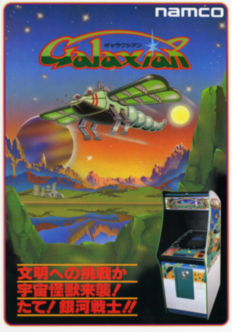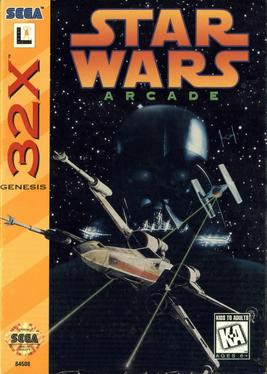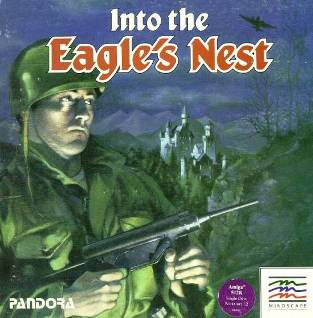
Galaxian is a 1979 fixed shooter arcade video game developed and published by Namco. The player assumes control of the Galaxip starfighter in its mission to protect Earth from waves of aliens. Gameplay involves destroying each formation of aliens, who dive down towards the player in an attempt to hit them.

Star Wars is a first-person rail shooter designed by Mike Hally and released as an arcade video game in 1983 by Atari, Inc. It uses 3D color vector graphics to simulate the assault on the Death Star from the 1977 film Star Wars. There are three connected gameplay sequences: combat against TIE fighters in space, flying across the surface of the Death Star, and the final trench run. The sequence repeats with added complications and the Death Star regenerating for each. The player's X-Wing fighter has a shield which only protects against damage a certain number of times, then the next hit ends the game. Speech synthesis emulates actors from the film.

Gravitar is a color vector graphics multidirectional shooter arcade video game released by Atari, Inc. in 1982. Using the same "rotate-and-thrust" controls as Asteroids and Space Duel, the game was known for its high level of difficulty. It was the first of over twenty games that Mike Hally designed and produced for Atari. The main programmer was Rich Adam and the cabinet art was designed by Brad Chaboya. 5,427 cabinets were produced. An Atari 2600 version by Dan Hitchens was published by Atari in 1983.

Over one hundred video games based on the Star Wars franchise have been released, dating back to some of the earliest home consoles. Some are based directly on films while others rely heavily on the Star Wars Expanded Universe.

John Berkey was an American artist known for his space and science fiction themed works. Some of Berkey's best-known work includes much of the original poster art for the Star Wars trilogy, the poster for the 1976 remake of King Kong and also the "Old Elvis Stamp".

Star Wars: The Empire Strikes Back is the sequel to the vector graphics Star Wars arcade video game released by Atari, Inc. in 1983. It was made available by Atari Games in 1985 as a conversion kit for the original game. As in Star Wars, the player takes on the role of Luke Skywalker in a set of battle sequences from a first-person perspective. The game features the Battle of Hoth and the subsequent escape of the Millennium Falcon through an asteroid field. It is the third Star Wars arcade title from Atari; the raster game Return of the Jedi came out the previous year.

Universal Hero is an action-adventure game released by Mastertronic in 1986 for the ZX Spectrum and in 1987 for the Atari 8-bit computers. The Spectrum version was developed by Stuart Middleton working under the name of Xcel Software. The Atari 8-bit port was commissioned by Mastertronic from a third-party developer.

Astro Chase is a multidirectional shooter written by Fernando Herrera for Atari 8-bit computers. It was published by First Star Software in 1982 as the company's first game. Parker Brothers licensed it, releasing cartridge versions for the Atari 8-bit family and Atari 5200 console in 1983 and a Commodore 64 version in 1984. Exidy licensed it for arcade use with its Max-A-Flex cabinet.

Star Wars Trilogy Arcade is an arcade game developed by Sega's AM Annex subsidiary and released in 1998. It is a 3D rail shooter based on the original trilogy of Star Wars films, released alongside their special editions. Accompanied by the Star Wars Trilogy pinball game, it is the second in Sega's Star Wars Arcade series; it is preceded by 1993's Star Wars Arcade and followed by 2000's Star Wars Racer Arcade.

Hades Nebula is a 1987 vertically scrolling shooter for the Commodore 64, ZX Spectrum and Atari ST by Paranoid Software and published by Nexus Productions. The player controls an upgradable fighter that must battle its way through thousands of enemy ships before it confronts the final boss, Emperor Hades. There are fifteen levels.

Star Wars is a 1993 arcade game developed by Sega and based on the original Star Wars trilogy. Combining elements of A New Hope and Return of the Jedi, the game has players pilot a Rebel starship and battle against the forces of the Empire. Sega developed Star Wars for their Model 1 system, the same arcade hardware that powered Virtua Fighter and Virtua Racing. Like those two titles, the graphics in Star Wars are rendered entirely using polygons. The game was given a home port under the name Star Wars Arcade, as an exclusive for the Sega 32X's launch in 1994.

Dandy is a dungeon crawl maze video game for Atari 8-bit computers published by the Atari Program Exchange in 1983. It is one of the first video games with four-player, simultaneous cooperative play. Players equipped with bows and unlimited arrows fight through a maze containing monsters, monster spawners, keys, locked doors, food, and bombs in search of the exit leading to the next level. If a player dies, they can be revived by finding and shooting a heart. The game includes an editor for making new dungeons.

Star Wars: Return of the Jedi is an isometric scrolling shooter released as an arcade video game in 1984 based on the film from the previous year. It was the second arcade release by Atari based on the Star Wars franchise, but using raster graphics rather than the vector graphics of the first and third arcade games. Several home ports were released by Domark for the Amstrad CPC, BBC Micro, ZX Spectrum, Atari ST, Commodore 64, and Amiga in 1988. The game is included as an unlockable extra on Star Wars Rogue Squadron III: Rebel Strike for GameCube.
Star Wars: X-Wing is a series of space flight simulator video games based in the Star Wars media franchise that attempts to simulate the fictional experience of starfighter combat, while remaining faithful to the movies. The player took the role of a pilot of the Rebel Alliance, and, in later games, the Galactic Empire. To complete the games, players must complete missions such as simple dogfights with opposition starfighters, reconnaissance and inspection tasks, escort duty for freighters or capital ships, or attacks on larger opposition ships. In addition to dogfighting designed to resemble the free-wheeling duels of World War I, the games also offered the challenge of managing power resources and wingmen, and using weapons effectively.

Star Wars: Jedi Arena is a lightsaber battle video game written by Rex Bradford for the Atari 2600 and published by Parker Brothers in 1983. It is the first Star Wars video game to feature lightsabers. The goal of the game, based on one scene in the original Star Wars film, is to take out the opponent with the Seeker ball while defending oneself from incoming laser blasts using one's lightsaber.

Beyond the Ice Palace is a platform game published by Elite Systems in 1988 for the Amiga, Amstrad CPC, Atari ST, Commodore 64, and ZX Spectrum.

Into the Eagle's Nest is a video game developed by Pandora and published in 1987 for Amiga, Amstrad CPC, Apple II, Atari ST, Commodore 64, IBM PC compatibles, and ZX Spectrum. Atari Corporation also released a cartridge version for the Atari 8-bit computers the following year on the Atari XEGS.

Star Wars Battle Pod is a 2014 arcade game based on the franchise Star Wars. It was unveiled at the New York Comic Con on October 8, 2014.


















